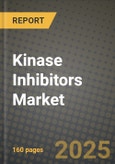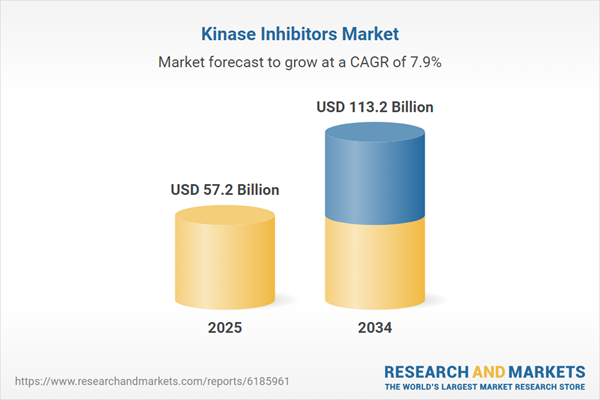The Kinase Inhibitors Market focuses on a class of drugs that block specific enzymes - kinases - that are involved in signaling pathways regulating cell growth, division, and survival. These inhibitors are most commonly used in oncology to treat cancers such as leukemia, lung, breast, and renal cancers, but their applications are expanding into autoimmune and inflammatory diseases. By targeting aberrant signaling cascades, kinase inhibitors offer a precise therapeutic approach, often with improved efficacy and reduced systemic toxicity compared to traditional chemotherapy. This market comprises both small molecule inhibitors and monoclonal antibodies, with ongoing research intensifying around personalized treatment, resistance mechanisms, and next-generation kinase targets.
The kinase inhibitors market experienced significant growth, driven by new drug approvals, expanded indications for existing therapies, and increased clinical trial activity. EGFR, BCR-ABL, ALK, and JAK inhibitors remained top-selling drug categories, while BTK and CDK inhibitors showed promise in hematologic malignancies and solid tumors. FDA and EMA approved multiple second- and third-generation inhibitors designed to overcome acquired resistance. The rise of biomarker-driven therapy selection boosted demand for companion diagnostics and molecular profiling tools. Companies like AstraZeneca, Novartis, and Pfizer focused on developing dual-target inhibitors and combination regimens. Meanwhile, biosimilars entered the scene in cost-sensitive regions, enhancing access to targeted treatments.
The kinase inhibitors market is poised for diversification into rare cancers, autoimmune disorders, and neurodegenerative diseases. Precision oncology will drive demand for mutation-specific kinase inhibitors tailored to individual tumor profiles. AI-powered drug discovery and CRISPR gene editing will accelerate identification of novel kinase targets. Resistance mitigation will remain a key R&D theme, prompting development of allosteric inhibitors and adaptive therapy models. Expansion into oral formulations, wearable delivery systems, and patient-centric dosing will enhance convenience and adherence. As regulatory frameworks embrace real-world evidence and personalized medicine, kinase inhibitors will continue to reshape the future of targeted therapeutics.
Key Insights: Kinase Inhibitors Market
- The analyst highlights the growing trend of developing dual-target or multi-kinase inhibitors that offer broader efficacy and combat resistance in complex cancers like NSCLC and CML.
- Biomarker-guided therapy selection is trending, with companion diagnostics playing a critical role in identifying patients likely to benefit from specific kinase inhibitors.
- According to the analyst, next-generation kinase inhibitors designed to overcome resistance mutations (e.g., T790M, C797S) are trending across clinical pipelines and new product launches.
- Application expansion beyond oncology into autoimmune conditions such as rheumatoid arthritis and psoriasis is trending, broadening Therapeutic landscape for kinase inhibitors.
- Real-world data and post-market surveillance are trending in influencing payer decisions and optimizing dosing regimens for better clinical outcomes and cost-effectiveness.
- The analyst identifies the rising global cancer burden and the shift toward targeted therapies as central drivers fueling kinase inhibitor development and adoption.
- Advancements in molecular diagnostics and personalized medicine are enabling precise patient stratification, increasing treatment success rates with kinase inhibitors, says the analyst.
- The analyst notes that ongoing clinical trials and FDA fast-track approvals are expediting market entry for novel inhibitors with first-in-class or best-in-class potential.
- Increasing collaboration between biotech startups and large pharmaceutical companies is accelerating R&D and commercialization of next-generation kinase inhibitors.
- The analyst highlights the issue of acquired resistance to kinase inhibitors over time, which reduces long-term treatment efficacy and necessitates ongoing drug modifications.
- According to the analyst, high costs and access disparities in emerging markets limit the widespread availability of newer kinase inhibitors, even when clinically indicated.
Kinase Inhibitors Market Segmentation
By Type
- Tyrosine Kinase Inhibitors
- Multikinase Inhibitors
- mTOR Kinase Inhibitors
- Other Types
By Route of Administration
- Oral
- Parenteral
- Other Routes
By Application
- Oncology
- Inflammatory Diseases
By Distribution Channel
- Hospital Pharmacy
- Online Pharmacy
- Retail Pharmacy
By End User
- Hospitals
- Homecare
- Specialty Clinics
- Other End-Users
Key Companies Analysed
- Pfizer Inc.
- Johnson & Johnson
- F. Hoffmann-La Roche Ltd
- Merck & Co. Inc.
- Bristol-Myers Squibb Company
- AstraZeneca Plc
- Abbott Laboratories
- Novartis AG
- GlaxoSmithKline PLC
- Takeda Pharmaceutical Company Limited
- Eli Lilly and Company
- Teva Pharmaceutical Industries Ltd
- Astellas Pharma Inc
- Cipla Inc
- Dr. Reddy's Laboratories Ltd
- Endo International Inc.
- Amneal Pharmaceuticals LLC
- Lupin Limited
- Exelixis Inc
- Glenmark Pharmaceuticals Ltd
- Torrent Pharmaceuticals Ltd
- Hutchison China MediTech Limited
- Akorn Incorporated
- Ocular Therapeutix Inc.
- Sierra Oncology Inc
Kinase Inhibitors Market Analytics
The report employs rigorous tools, including Porter’s Five Forces, value chain mapping, and scenario-based modeling, to assess supply-demand dynamics. Cross-sector influences from parent, derived, and substitute markets are evaluated to identify risks and opportunities. Trade and pricing analytics provide an up-to-date view of international flows, including leading exporters, importers, and regional price trends.Macroeconomic indicators, policy frameworks such as carbon pricing and energy security strategies, and evolving consumer behavior are considered in forecasting scenarios. Recent deal flows, partnerships, and technology innovations are incorporated to assess their impact on future market performance.
Kinase Inhibitors Market Competitive Intelligence
The competitive landscape is mapped through proprietary frameworks, profiling leading companies with details on business models, product portfolios, financial performance, and strategic initiatives. Key developments such as mergers & acquisitions, technology collaborations, investment inflows, and regional expansions are analyzed for their competitive impact. The report also identifies emerging players and innovative startups contributing to market disruption.Regional insights highlight the most promising investment destinations, regulatory landscapes, and evolving partnerships across energy and industrial corridors.
Countries Covered
- North America - Kinase Inhibitors market data and outlook to 2034
- United States
- Canada
- Mexico
- Europe - Kinase Inhibitors market data and outlook to 2034
- Germany
- United Kingdom
- France
- Italy
- Spain
- BeNeLux
- Russia
- Sweden
- Asia-Pacific - Kinase Inhibitors market data and outlook to 2034
- China
- Japan
- India
- South Korea
- Australia
- Indonesia
- Malaysia
- Vietnam
- Middle East and Africa - Kinase Inhibitors market data and outlook to 2034
- Saudi Arabia
- South Africa
- Iran
- UAE
- Egypt
- South and Central America - Kinase Inhibitors market data and outlook to 2034
- Brazil
- Argentina
- Chile
- Peru
Research Methodology
This study combines primary inputs from industry experts across the Kinase Inhibitors value chain with secondary data from associations, government publications, trade databases, and company disclosures. Proprietary modeling techniques, including data triangulation, statistical correlation, and scenario planning, are applied to deliver reliable market sizing and forecasting.Key Questions Addressed
- What is the current and forecast market size of the Kinase Inhibitors industry at global, regional, and country levels?
- Which types, applications, and technologies present the highest growth potential?
- How are supply chains adapting to geopolitical and economic shocks?
- What role do policy frameworks, trade flows, and sustainability targets play in shaping demand?
- Who are the leading players, and how are their strategies evolving in the face of global uncertainty?
- Which regional “hotspots” and customer segments will outpace the market, and what go-to-market and partnership models best support entry and expansion?
- Where are the most investable opportunities - across technology roadmaps, sustainability-linked innovation, and M&A - and what is the best segment to invest over the next 3-5 years?
Your Key Takeaways from the Kinase Inhibitors Market Report
- Global Kinase Inhibitors market size and growth projections (CAGR), 2024-2034
- Impact of Russia-Ukraine, Israel-Palestine, and Hamas conflicts on Kinase Inhibitors trade, costs, and supply chains
- Kinase Inhibitors market size, share, and outlook across 5 regions and 27 countries, 2023-2034
- Kinase Inhibitors market size, CAGR, and market share of key products, applications, and end-user verticals, 2023-2034
- Short- and long-term Kinase Inhibitors market trends, drivers, restraints, and opportunities
- Porter’s Five Forces analysis, technological developments, and Kinase Inhibitors supply chain analysis
- Kinase Inhibitors trade analysis, Kinase Inhibitors market price analysis, and Kinase Inhibitors supply/demand dynamics
- Profiles of 5 leading companies - overview, key strategies, financials, and products
- Latest Kinase Inhibitors market news and developments
Additional Support
With the purchase of this report, you will receive:- An updated PDF report and an MS Excel data workbook containing all market tables and figures for easy analysis.
- 7-day post-sale analyst support for clarifications and in-scope supplementary data, ensuring the deliverable aligns precisely with your requirements.
- Complimentary report update to incorporate the latest available data and the impact of recent market developments.
This product will be delivered within 1-3 business days.
Table of Contents
Companies Mentioned
- Pfizer Inc.
- Johnson & Johnson
- F. Hoffmann-La Roche Ltd.
- Merck & Co. Inc.
- Bristol-Myers Squibb Company
- AstraZeneca PLC
- Abbott Laboratories
- Novartis AG
- GlaxoSmithKline PLC
- Takeda Pharmaceutical Company Limited
- Eli Lilly and Company
- Teva Pharmaceutical Industries Ltd.
- Astellas Pharma Inc.
- Cipla Inc.
- Dr. Reddy's Laboratories Ltd.
- Endo International Inc.
- Amneal Pharmaceuticals LLC
- Lupin Limited
- Exelixis Inc.
- Glenmark Pharmaceuticals Ltd.
- Torrent Pharmaceuticals Ltd.
- Hutchison China MediTech Limited
- Akorn Incorporated
- Ocular Therapeutix Inc.
- Sierra Oncology Inc.
Table Information
| Report Attribute | Details |
|---|---|
| No. of Pages | 160 |
| Published | October 2025 |
| Forecast Period | 2025 - 2034 |
| Estimated Market Value ( USD | $ 57.2 Billion |
| Forecasted Market Value ( USD | $ 113.2 Billion |
| Compound Annual Growth Rate | 7.8% |
| Regions Covered | Global |
| No. of Companies Mentioned | 25 |









